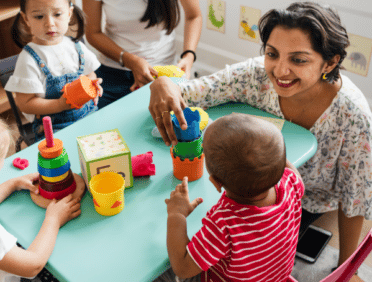Filter by
Safeguarding Children in the UK
The protection of children in the United Kingdom is an essential component in ensuring the kids of the country are safe, healthy, and able to realise their full potential. The United Kingdom (UK) is committed to protecting children from being abused, neglected, or exploited through the implementation of a variety of policies and procedures.
We will look at the most important aspects of protecting children in the United Kingdom, including the laws that are in place, the organisations that are engaged, and the activities that can be taken to ensure the safety of children.
Legislation and Policies
The legal system in the United Kingdom is very strong, and it includes a number of important legislation and standards that are designed to safeguard children.
The Children Act 1989 and 2004
The Children Act of 1989 is the legislation that establishes the primary framework for child protection in the United Kingdom. It places a strong emphasis on the well-being of children. Through the implementation of measures for integrated children’s services and the establishment of the function of the Children’s Commissioner, the amendment that was passed in 2004 significantly strengthened this framework.
Working Together to Safeguard Children (2018)
This piece of statutory guidance emphasises the duties that individuals and organisations have to collaborate on in order to protect and advance the wellbeing of children. It highlights the importance of making sure that all of the organisations that are involved in child protection have a coordinated strategy.
Key Organisations
The protection of children in the United Kingdom is the responsibility of a number of different organisations.
Local Safeguarding Children Boards (LSCBs)
The establishment of LSCBs was done with the intention of ensuring that local agencies collaborate in order to protect children. Safeguarding Partners, which consists of local governments, healthcare providers, and law enforcement, have taken their place.
The NSPCC
One of the most prominent charitable organisations that focuses on the safety of children is the National Society for the Prevention of Cruelty to Children (NSPCC). In addition to providing direct services to children, they also work to increase awareness and push for legislative changes that will strengthen child protection strategies.
Recognising and Responding to Abuse
Understanding the warning signs of abuse and knowing how to respond to them is essential for the protection of children.
Types of Abuse
The term “physical abuse” refers to the imposition of bodily harm.
Abuse of the emotions can take many forms, including verbal abuse, threats, and continuous criticism.
A child is said to be subjected to sexual abuse when they are coerced or enticed into engaging in sexual behaviours.
Failure to address a child’s fundamental emotional and physical needs on a consistent basis is the definition of neglect.
Recognising Signs of Abuse
Abuse can manifest itself in a variety of ways, but some of the signs that may be present are injuries that cannot be explained, changes in behaviour, dread of particular people, and poor hygiene or starvation.
Reporting and Intervention
Abuse should be reported to the local authorities or the National Society for the Prevention of Cruelty to Children (NSPCC) if it is suspected. For the purpose of ensuring the child’s protection, immediate intervention may require the involvement of social services and the police.
Preventative Measures
One of the most important aspects of safeguarding is prevention, which includes education, awareness, and policies that are proactive.
Education and Training
The importance of teaching children about their rights and how to identify instances of abuse cannot be overstated. In order to guarantee that professionals who work with children are able to recognise and respond appropriately to instances of abuse, it is equally critical that they receive additional training.
Safe Recruitment Practices
Establishing tight recruitment standards, which may include conducting background checks, is necessary for organisations that work with children in order to guarantee the safety of the children in their care.
Frequently Asked Questions (FAQs)
The prevention of harm to children and the promotion of their well-being are the two primary goals of the safeguarding process. It entails safeguarding children against mistreatment and abuse, preventing harm to children’s health or development, ensuring that children are provided with safe and effective care as they grow up, and implementing measures to ensure that all children are able to achieve the greatest possible outcomes.
The fact that every child has the right to live a life free from abuse and neglect is the reason why it is crucial. Safeguarding procedures help ensure that children are safe and healthy. We need to ensure that children grow up in a healthy manner and are able to realise their full potential. Effective safeguarding can prevent the devastating repercussions of abuse over the long term.
Among the fundamental tenets of child protection in the United Kingdom are the following:
The wellbeing of the child should be the primary concern in any and all decisions and activities that have an impact on them, according to the principle of paramountcy.
The best course of action is to take preventative measures before any damage is done. It is crucial that children be shielded from any form of mistreatment or injury.
Partnership
It is essential to collaborate with families and other organisations in order to guarantee the greatest possible outcomes for children of all ages.
Accountability
Both individuals and organisations are required to take responsibility for the actions and choices they make in relation to prevention and protection.
The purpose of these principles is to guarantee that a holistic approach to safeguarding is taken, one that takes into account the rights and requirements of the child while also incorporating all key parties in the process.
It is the obligation of numerous parties to ensure the safety of children, which is a joint responsibility.
The primary responsibility for the health and safety of children resides with their parents and other carers. This responsibility extends to the children themselves.
Individuals who work with children, such as teachers, social workers, healthcare providers, and police officers, have a responsibility to protect children. Examples of professionals who fall into this category include teachers.
Those organisations that provide services to children, such as schools, healthcare providers, and other organisations, are required to have safeguarding policies and procedures in place.
Individuals from the general public also have a part in the process of safeguarding by maintaining vigilance and reporting any concerns they may have.
Each and every member of society has a responsibility to play in the protection of children, making certain that they are protected and well-cared for.
Several pieces of legislation, including the following, govern the protection of children in the United Kingdom:
This important piece of law, which was passed in 1989, is known as the Children Act, and it is responsible for providing a comprehensive framework for the care and protection of children.
This act, known as the Children Act of 2004, was responsible for establishing the position of the Children’s Commissioner as well as the Local Safeguarding Children Boards (LSCBs).
Act of 2006 Concerning the Safeguarding of Vulnerable Groups
This Act establishes the structure for the vetting and barring system, which is designed to prevent individuals who are not suited for working with children from doing so.
The Act of 2017 Relating to Children and Social Work
This Act includes provisions that will boost support for children who are looked after as well as for children who have left foster care. The purpose of these provisions is to reinforce the arrangements for the protection of children.
The collective effect of these laws is to establish a solid framework for the protection of children in the United Kingdom.
Children in the United Kingdom are protected under the Children Act of 1989, which is a fundamental law. The notion that the welfare of the child is of the utmost importance is presented, and it outlines the responsibilities that local authorities and other organisations have to do in order to protect and advance the welfare of children. A number of important provisions of the Act are as follows:
The Act specifies who is responsible for parenting as well as the rights and responsibilities that come along with that obligation.
Municipalities are obligated to provide services to children who are in need and to conduct investigations if they have reason to believe that a child is suffering or is going to suffer serious harm.
The Act grants the courts the authority to issue a variety of measures, including care orders and supervision orders, in order to safeguard the welfare of children.
Because of the Children Act of 1989, safeguarding processes have been significantly altered, a child-centered approach has been ensured, and collaboration among various agencies has been encouraged.
There are several different signs that can indicate that a child has been abused or neglected.
Physical Abuse
Bruises, fractures, or burns that cannot be explained—fear of coming home or fear of parents—are all examples of physical abuse.
Emotional Abuse
The following are characteristics of emotional abuse: developmental delays, excessive behaviour (either aggressive or withdrawn), and a lack of relationship with the parent by the child.
Sexual Abuse
Inappropriate sexual behaviour or knowledge for the child’s age, as well as physical symptoms, are all examples of inappropriate sexual abuse.
Neglect
Deficiencies in sanitation, malnutrition, unmet medical needs, and a persistent absence of monitoring are all examples of neglect.
At the same time, it is essential to be watchful and report any concerns in order to guarantee that children receive the assistance and protection they require.
Report your concerns to the proper authorities if you have any reason to believe that a child is being neglected or mistreated.
It is possible to:
Get in touch with the local authority
You should bring your concerns to the attention of the local department of children’s services. In addition to conducting investigations, it is their responsibility to take action.
Notify the authorities
In the event of an emergency in which a child is in immediate danger, use the number 999.
NSPCC should be contacted
The National Society for the Prevention of Cruelty to Children (NSPCC) offers a helpline that is open round-the-clock (0808 800 5000) for the purpose of offering advice and reporting concerns.
To make a meaningful impact on the life of a child, it is essential to take action on any worries that you have, even if you are unclear of what to do.
While the Local Safeguarding Children Board (LSCB) is responsible for coordinating and supervising actions related to child protection within a local region, it plays an important part in this process.
The following are important responsibilities:
Creating Policies and Procedures for Implementation
The formulation of recommendations for the production of safeguarding policies that are applicable to all businesses.
Instruction as well as Awareness
As well as increasing public awareness of safeguarding issues, providing training for professionals is also important.
Case Reviews That Are Serious
Conduct reviews in the event that a kid passes away or has major injuries. It is possible to identify lessons learned and improve practices.
The Process of Monitoring and Assessing
Conducting an evaluation of the efficiency of the work protection measures and ensuring that they are continuously improved.
The Local Social Care Board (LSCB) is responsible for ensuring that all agencies collaborate efficiently in order to protect children and advance their wellbeing.
It is expected of individuals who work with children that they will successfully complete rigorous safeguarding training in order to ensure that they are able to successfully detect and respond to symptoms of abuse and neglect.
Typically, the training consists of the following:
Instruction on Fundamental Awareness
The essentials of safeguarding, including the ability to recognise symptoms of abuse and the procedures for reporting concerns, are covered in this training, which is intended for all staff members and volunteers.
Training on Advanced Safeguarding Techniques
This course investigates safeguarding issues and procedures in greater depth for those who hold more senior positions or who have specific obligations, such as those who work in the healthcare or education fields.
The Training of Specialists
A comprehensive awareness of safeguarding regulations, the ability to collaborate with several agencies, and the ability to handle complex cases are required for positions such as Designated Safeguarding Leads (DSLs).
Regularly Occurring Refresher Courses
The purpose of these courses is to ensure that information is kept current and up-to-date with any changes that may be made to policies or legislation.
All individuals who work with children are provided with the necessary training to ensure that they are able to establish a secure environment and respond appropriately in the event that a child is in danger.
Implementing stringent safeguarding policies and processes, such as the following, will help schools guarantee the protection of their kids.
Comprehensive Safeguarding Policy
Having a safeguarding policy that is easy to understand and accessible, which states the school’s commitment to protecting children and the procedures for which concerns are to be handled.
Vetting and Recruitment
Conducting comprehensive background checks on all of the personnel and volunteers, including checks with the Disclosure and Barring Service (DBS).
This is the Designated Safeguarding Lead, or DSL
Appointing a DSL who is responsible for controlling safeguarding processes, offering assistance and training to staff members, and serving as the primary point of contact for any safeguarding issues that may arise.
Instruction and Awareness Training
Making sure that every member of staff receives regular training on safeguarding, in addition to being aware of the warning signs of abuse and how to report concerns.
Safe Environment
Implementing anti-bullying regulations and encouraging positive conduct are two aspects of the process of creating a safe environment for pupils, both physically and emotionally.
The Participation of Parents
The school is working closely with parents and carers to ensure that they are aware of the school’s safeguarding policy and how they may contribute to the safety of their child.
If schools uphold these standards, they can create a secure environment where kids can learn and flourish.
A Designated Safeguarding Lead, often known as a DSL, is a senior member of staff in an educational institution or social organisation who is accountable for taking the lead on matters pertaining to child safety and safeguarding.
Among the most important duties of a DSL are the following:
Managing referrals means
ensuring that any concerns regarding the safety or welfare of a child are reported to the proper authorities in the event that they arise.
Support and Training
It is important to provide workers with training and support on safeguarding problems, as well as to ensure that they are aware of the policies and procedures that affect them.
Policy Development
This refers to the process of formulating and evaluating the policies and procedures of the organisation with the intention of safeguarding its members.
Liaison
Acting as a liaison between the organisation and other agencies, such as children’s social care and the police, is an important part of the role of the liaison.
Record-Keeping
Keeping records that are both detailed and accurate of any concerns regarding safety and the steps that have been taken.
Preventative Work
Promoting a culture of safeguarding within the organisation, which includes increasing awareness and offering guidance and assistance to both the staff and the children enrolled in the programme.
To ensure that safeguarding policies are adequately implemented and that children are safeguarded from danger, the DSL plays a crucial role in ensuring that these policies are followed.
The allegations of misconduct that have been made against members of the staff must be handled with the highest seriousness and in accordance with the processes that have been established.
The following are important steps:
Immediate Action
In the event that it is required, removing the suspected perpetrator from a position of authority and ensuring the immediate protection of the child are both important steps.
Reporting
Providing notification to the Local Authority Designated Officer (LADO) or the equivalent in your region, who is responsible for monitoring allegations made against staff members.
Investigation
Conducting an inquiry that is both comprehensive and impartial, while also ensuring that confidentiality and the rights of all parties involved are honoured.
Suspension
In the event that it is deemed necessary, suspend the employee while the inquiry is being carried out.
Support
The provision of assistance Offering help to the child and their family, in addition to the staff person who is involved in the problem, is something that should be done simultaneously.
The implementation of necessary measures in response to the findings of the investigation, which may include disciplinary action or referral to authorities from outside the organisation. By following these procedures, you can ensure that allegations are treated in a fair manner and that the highest priority is placed on the safety of children.
Prevent duty is a component of the counter-terrorism strategy that the government of the United Kingdom has implemented, with the objective of preventing people from becoming involved in terrorist activities.
It relates to the protection of children by the following ways:
Identifying Vulnerabilities
A youngster’s or young person’s vulnerability to radicalization can be identified by recognising certain indications.
Training and Awareness
Offering training to staff members on how to recognise and respond to indicators of radicalization is becoming increasingly important.
Preventive Measures
Monitoring children’s use of the internet and encouraging critical thinking are two things that can be done to shield children from the influence of extremists.
Reporting Concerns
Notifying the proper authorities, such as the local Prevent team or Channel programme, of any concerns regarding radicalization is a good idea.
It is possible for organisations to assist in protecting children from the dangers of radicalization and extremist influences by implementing the Prevent obligation into safeguarding practices of the organisation.
Through education, parents and other carers may guarantee that their children are safe when using the internet.
Instructing youngsters about the dangers of the internet and the ways in which they can protect themselves, such as avoiding the disclosure of personal information and identifying suspicious activity, is essential.
Supervision of activities
Monitoring their child’s usage of the internet and establishing clear boundaries, such as restricting the amount of time their child spends in front of a screen and utilising parental controls.
Open Communication
Fostering an environment that encourages open discussion with their children regarding their activity on the internet and any concerns parents may have.
Using Technology
It is advised that security software and parental control apps be installed on a device in order to restrict access to potentially hazardous content and to monitor activities that are carried out online.
Staying Informed
Keeping abreast on the most recent developments in e-commerce, mobile applications, and cybersecurity threats.
It is possible for parents and other caretakers to aid in ensuring that their children have a positive and secure experience when using the internet by following to these rules and ensuring that they are followed.
There are several essential steps involved in carrying out a risk assessment for safeguarding:
Assess Risks
Investigate the factors that could potentially cause harm to children, including those that are physical, emotional, and online.
Implement Controls
Evaluate the chance of these dangers occurring as well as the possible impact they could have, taking into consideration the particular circumstances and requirements of the children who are involved.
Assess Risks
It is important to take steps to mitigate the risks that have been discovered. Some of these actions include enhancing physical security, offering training to workers, and establishing clear reporting protocols.
Record Findings
Document the process of risk assessment, including the hazards that were discovered, the risks that were evaluated, and the controls that were put into place.
Review and Revise
Review and update the risk assessment on a regular basis to ensure that it accurately reflects any changes in the environment, newly discovered hazards, or incidents that have taken place.
With the support of this methodical approach, organisations are able to establish a more secure environment for children.
The following are some of the ways in which community organisations can make a contribution to the protection of children: Awareness and Training: Providing training on child protection and creating awareness among workers, volunteers, and members of the community.
Creating Safe Spaces
Ensuring that children are able to participate in activities and facilities that are both safe and welcoming.
Working Partnership
Participating in cooperative efforts with other organisations, such as schools, local government, and law enforcement, in order to exchange information and resources.
Reporting Concerns
Ensuring that members of the community are aware of how to report any concerns they may have regarding the well-being of a kid and encouraging them to do so.
Support Services
The provision of support services for children and families, including counselling, mentorship, and recreational activities, among other things.
It is essential to provide children who have been mistreated with support in order to assist them in recovering and rebuilding their lives. There are many other types of support available, such as counselling and therapy.
Counselling and Therapy
Counselling and therapeutic services provided by trained professionals to assist youngsters in processing their experiences and feelings.
Medical Care
Access to medical treatment for any physical injuries that may have been sustained, as well as medical care that is continuing.
Child Protection Services
Social services are able to offer continuous support and protection, including temporary foster care in the event that it is required.
Legal Support
Help with Legal Matters Legal assistance and support throughout the legal process, including assistance from child advocates and interaction with law enforcement.
Educational Support
You will be provided with aid with continuing education in a safe environment, which may include assistance from specialised professionals inside schools.
Support Groups
Children and their families have access to support groups where they can talk about their experiences and receive support from their peers.
Helplines and Online Services
There are confidential helplines available, such as Childline, as well as online services that offer quick support and advice.
The purpose of these services is to assure the child’s physical and mental rehabilitation and to assist them in moving forward in an environment that is both safe and supportive.
The following are some of the ways in which social services contribute significantly to the protection of children:
Assessment
Assessment is the process of assessing whether or not a child is in danger of being harmed and deciding what the child’s requirements are. Assessment is also the time when the child is evaluated.
Intervention
The implementation of interventions with the intention of safeguarding children, which may include the placing of children in temporary care or working together with families to find solutions to issues that have arisen.
Support
Providing children and families with ongoing support, which may include access to services such as psychotherapy, housing, and financial assistance, is one way in which help is made available.
Cooperation and coordination
Collaborating with other organisations, including schools, healthcare providers, and law enforcement, to ensure that a coordinated strategy to protect is taken.
Monitoring
Monitoring the child’s situation on a consistent basis in order to guarantee their safety and well-being.
Legal Action
It is possible to initiate legal procedures in order to protect a child, such as asking court orders to remove a child from a dangerous setting, if it is determined that it is necessary to do so.
When it comes to ensuring that children are safeguarded from danger and that their needs are met in a manner that is both comprehensive and coordinated, social services play a crucial role.
Volunteers who deal with children are required to undergo thorough screening and training in order to guarantee that they are suitable for the duties they are assigned.
These are the typical components of the process:
Background Checks
Extensive background investigations, including a DBS (Disclosure and Barring Service) check, are required in order to guarantee that the volunteer does not have a criminal record that would prevent them from working with children. This is the primary reason for doing these checks.
References
In order to ascertain whether or not the volunteer is suitable for the position, references are verified by contacting previous employers or other individuals who are pertinent to the role.
Interview
During the interview, the volunteer’s motivation, experience, and level of comprehension about child protection will be evaluated.
Safeguarding Training
Training for Safeguarding Offer complete training for safeguarding, which includes the ability to recognise symptoms of abuse, comprehend policies and procedures, and be aware of how to report concerns.
Ongoing Training
Ongoing Training With the goal of ensuring that volunteers receive regular updates on any changes to safeguarding policy or regulations, as well as regular refresher training.
Supervision
Volunteers should be provided with consistent supervision and support in order to guarantee that they are carrying out their responsibilities in a manner that is both successful and safe.
It is necessary to take these measures in order to guarantee that volunteers are appropriately equipped to work with children and to make a positive contribution to the children’s safety and well-being.
Abuse can take many forms, and the law in the UK recognises them all.
Physical Abuse
Beating, shaking, burning, or poisoning a child are all examples of physical abuse that can be inflicted on a child.
Emotional Abuse
Persistent emotional maltreatment, which includes bullying, humiliation, and verbal abuse among other forms of abuse, can have a negative impact on a child’s emotional development.
Sexual Abuse
Child sexual abuse refers to the act of coercing or luring a child to engage in sexual acts. Persistent emotional maltreatment, which includes bullying, humiliation, and verbal abuse, among other forms of abuse, can have a negative impact on a child’s emotional development. Not meeting the fundamental requirements of a child, which include providing them with sufficient food, clothing, housing, medical treatment, and supervision.
Exploitation
The use of a kid for the benefit or profit of another individual, including but not limited to child labour, trafficking, and forced participation in criminal activities.
The ability to detect and respond correctly to situations in which a child may be in danger requires having a solid awareness of the various forms of abuse that are out there.
Taking into account the specific vulnerabilities that children with impairments possess, it is necessary to take additional precautions when protecting them. A few key distinctions are as follows:
Increased Risk
Children who have impairments may be more susceptible to being abused or neglected than other children because of their need on carers and the difficulties they face in communicating with others.
Tailored Communication
One of the safeguarding measures that must be implemented is the utilisation of effective communication tactics, such as the use of sign language or other assistive technologies.
Accessibility
Children who have impairments should be able to access all of the safeguarding services and environments that are available.
Specialised Training
Providing staff and volunteers with specialised training on the specific needs and vulnerabilities of children with disabilities requires a lot of planning and preparation.
Parental Support
Parental help is the provision of additional support and resources to those who are acting as carers or parents of children with disabilities. This is done with the intention of assisting these individuals in effectively protecting their children.
These considerations are of considerable aid in ensuring that children with disabilities are provided with the essential protection and assistance necessary to meet their needs.
When it comes to protecting children in an efficient manner, multi-agency functioning entails coordination between many organisations and professionals.
Among the vital roles are:
Information Sharing
A thorough picture of the child’s circumstances can be achieved through the sharing of pertinent information among the various agencies involved.
Coordinated Response
In order to ensure that all agencies are working together towards common goals, it is necessary to have a coordinated response to issues regarding safeguarding.
Joint Assessments
Joint evaluations are being carried out in order to determine the requirements and dangers that the kid faces, and a coordinated plan of action is being developed.
Specialist Expertise
Bringing together professionals with a variety of experience can result in a more effective strategy for addressing challenging safeguarding issues.
Consistent Support
Making certain that children and families are provided with consistent assistance and services from all of the organisations that are engaged.
Through the pooling of resources and experience from a variety of fields, multi-agency collaboration brings about an improvement in the capacity to safeguard children.
The following are some of the most important processes involved in the implementation of safeguarding measures in a childcare setting:
Policy Development
The development of comprehensive safeguarding policies that provide specifics regarding the procedures for identifying and addressing concerns and worries with regard to the individual.
Training
Make sure that all of the staff and volunteers receive frequent training on how to protect themselves.
Designated Safeguarding Lead (DSL)
Appointing a DSL to supervise safeguarding processes and serve as the primary point of contact for issues is a good solution.
Clear Procedures
The establishment of transparent protocols for the reporting and handling of concerns about the protection of individuals.
Safe Recruitment
The establishment of secure recruitment standards, which include the execution of extensive background checks and the deployment of vetting methods and methodologies.
Parental Involvement
Participating in conversations with parents and carers to ensure that they are aware of the safeguarding policies and procedures for their children.
Regular Reviews
Ensure that safeguarding policies are kept up-to-date and effective by conducting frequent reviews and revisions of those policies.
When it comes to childcare settings, these strategies contribute to the creation of an environment that is both safe and helpful for children.
In the context of children and families, “early help” refers to the provision of assistance at the earliest possible stage, when difficulties are first detected. Prevention is one of the ways it helps to protect.
Prevention
It is important to address difficulties before they become more significant problems, as this will reduce the likelihood of harm occurring.
Support Services
It is possible to meet individual requirements by providing a variety of services, such as parenting programmes, psychotherapy, and educational help.
Multi-Agency Approach
A multi-agency approach is one that involves a number of different organisations working together in order to provide comprehensive support that is tailored to the needs of the family and the parent.
Empowerment
Giving families the ability to create their own solutions and build resilience is a necessity.
Continuous Monitoring
Regularly reviewing the child’s progress and changing support as needed.
The purpose of early help is to provide timely intervention with the intention of promoting favourable outcomes and reducing the need for more intensive care in the future.
The following are the components that make up the safeguarding policy for youth sports programmes:
Safeguarding Policy
A precise protection policy that is particular to the sports programme is being developed and put into action.
Training and Awareness
Making sure that workers, volunteers, and coaches receive instruction on how to protect themselves.
Designated Safeguarding Officer (DSO)
The appointment of a Designated Safeguarding Officer (DSO) ensures that safeguarding actions within the programme are supervised and coordinated.
Code of Conduct
The establishment of a code of conduct for all employees, volunteers, and young athletes who are participating in the event.
Safe Recruitment
Ensure that all personnel who work with children are subjected to comprehensive background checks and pre-employment screenings.
Open Communication
In order to encourage children to feel comfortable reporting issues, it is important to create an environment that is both open and safe.
Parental and Carer Engagement
Participation of Parents and Carers Participation of parents and carers in the process of child protection, including ensuring that they are informed and engaged in the process.
The use of these protocols can ensure that youth sports programmes provide young athletes with a positive and secure environment. Youth sports programming can provide this environment.














